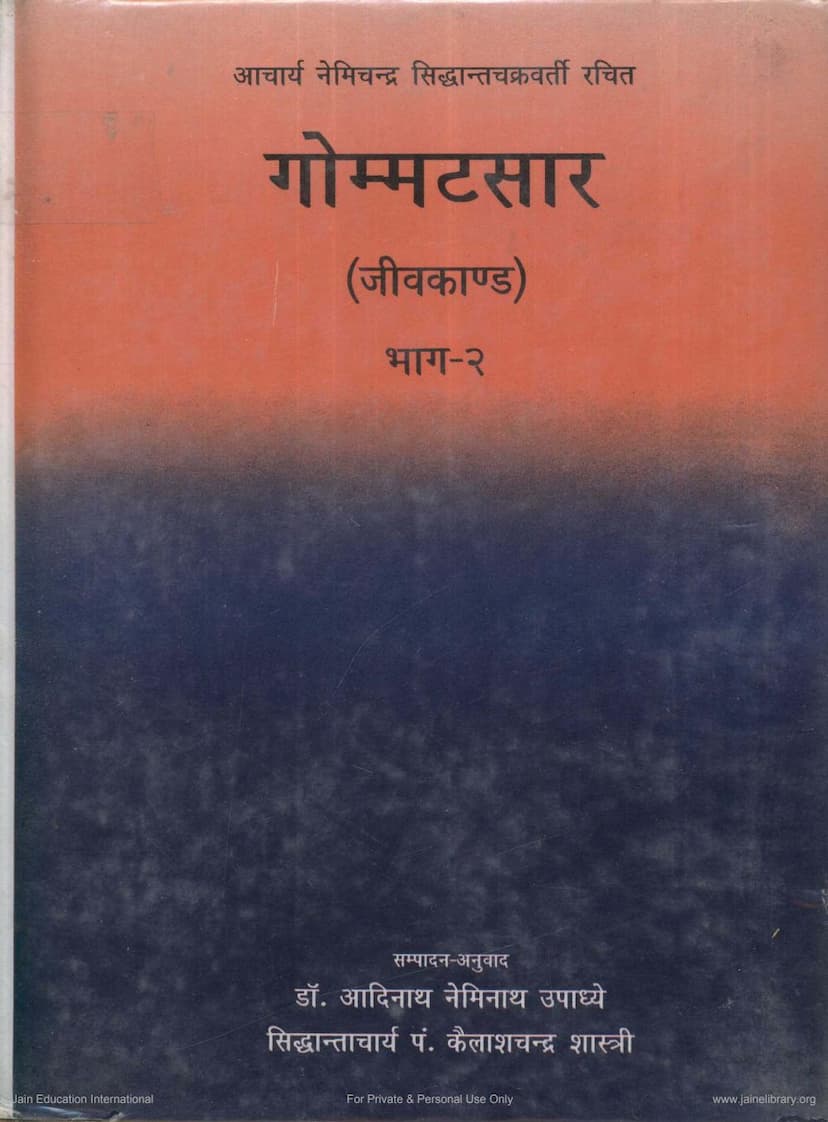Gommatasara Jiva Kanda Part 2
Added to library: September 1, 2025

Summary
Here is a comprehensive summary in English of the Jain text "Gommatasara Jiva Kanda Part 2," based on the provided pages and catalog link:
Gommatasara Jiva Kanda Part 2: A Summary
Introduction and Publisher:
- Title: Gommatasara Jiva Kanda Part 2
- Author: Nemichandra Siddhanta Chakravarti
- Editors/Translators: Dr. Adinath Nemnath Upadhye Siddhantacharya, Pt. Kailashchandra Shastri
- Publisher: Bharatiya Jnanpith
- Publication Details: This is a significant work explaining the Jiva-tattva (essence of the soul) and Karma-siddhanta (theory of karma) in Jainism. It was originally composed by Acharya Nemichandra Siddhanta Chakravarti in the 10th century in two parts: Gommatasara Jiva Kanda and Gommatasara Karma Kanda. This specific edition, published by Bharatiya Jnanpith in 1978-1981, is a comprehensive four-volume set including the original Prakrit verses, Karnata commentary by Shrimat Keshavavarni, Sanskrit commentary (Jivatattvapradipika), and Hindi translation with a detailed introduction. This new edition is dedicated to scholars and enthusiasts of Jain philosophy.
Content Overview (Based on the Index):
The text delves deeply into the Jain philosophy of the soul and its journey through various states of existence, primarily focusing on "Mārgṇās" (paths or categories of investigation). Part 2 of the Jiva Kanda covers several crucial topics, as detailed in the extensive table of contents provided:
-
Chapter 12: Jñāna Mārgaṇā (Path of Knowledge):
- Discusses the nature of knowledge in general, its various classifications (mati, shruta, avadhi, manahparyaya, kevala).
- Explores the causes and characteristics of incorrect knowledge (mithyājñāna).
- Details the specific knowledge in different spiritual stages (guṇasthānas).
- Provides extensive information on the types of mati-shruta knowledge, including avagraha, īhā, avāya, dhāraṇā, and the various classifications based on senses and mind.
- Elaborates on avadhi knowledge, including its types (desha, pradesha, paramāvadhi), causes, and scope.
- Covers manahparyaya knowledge and its intricacies.
- Finally, discusses kevala jñāna (omniscience).
- Analyzes the number of souls in each knowledge category.
-
Chapter 13: Sañyama Mārgaṇā (Path of Restraint):
- Defines sañyama (restraint or discipline) and its causes.
- Explains the types of sañyama: sāmayika, chedopasthāpanā, and asam-mayika (unrestrained).
- Details the spiritual stages associated with sañyama.
- Discusses the concept of virati (abstinence) and its stages (deshavirat).
- Analyzes the nature of asanyata (unrestrained soul).
- Calculates the number of souls in different stages of sañyama.
-
Chapter 14: Darśana Mārgaṇā (Path of Perception):
- Explains darśana (perception) in general.
- Differentiates between chakshu darśana (visual perception) and achakshu darśana (non-visual perception).
- Discusses kevala darśana (pure perception).
- Analyzes the number of souls in each perception category.
-
Chapter 15: Leśyā Mārgaṇā (Path of Leśyā):
- Defines leśyā (subtle karmic matter coloring the soul).
- Explains the six types of leśyās (Krishna, Nīla, Kāpota, Tejas, Padma, Shukla).
- Details the characteristics and manifestation of each leśyā.
- Discusses the occurrence of leśyās in different life forms and spiritual stages.
- Analyzes the transference (saṅkramaṇa) between leśyās.
- Calculates the number of souls with different leśyās.
-
Chapter 16: Bhavya Mārgaṇā (Path of Favorable Souls):
- Defines bhavyas (souls capable of attaining liberation) and abhavvyas (souls incapable of liberation).
- Discusses the spiritual potential and journey of souls.
- Analyzes the number of souls in each category.
-
Chapter 17: Samyak-tva Mārgaṇā (Path of Right Faith/Conduct):
- Defines samyak-tva (right faith and conduct) as essential for spiritual progress.
- Explains the types of samyak-tva: kṣāyika (due to destruction), aupśamika (due to subsidence), and kṣāyopśamika (due to partial destruction and subsidence).
- Details the spiritual stages where each type of samyak-tva is attained.
- Analyzes the number of souls with each type of samyak-tva.
-
Chapter 18: Sañji Mārgaṇā (Path of Sentient Beings):
- Defines sañjñī (sentient beings with mind) and asañjñī (non-sentient beings without mind).
- Discusses the characteristics and presence of sañjñī and asañjñī souls.
- Analyzes the number of souls in these categories.
-
Chapter 19: Āhāra Mārgaṇā (Path of Sustenance):
- Explains the concept of āhāra (sustenance) in Jainism.
- Discusses the different types of āhāra and their relation to souls.
- Analyzes the number of souls in different states of āhāra.
-
Chapter 20: Upayoga Mārgaṇā (Path of Utilization):
- Defines upayoga (utilization or conscious activity) of the soul.
- Explains the types of upayoga: jñāna (knowledge) and darśana (perception).
- Differentiates between sakāra (with form) and anākāra (without form) upayoga.
- Analyzes the number of souls according to their upayoga.
-
Chapter 21: Ōghādeśa Prarūpaṇādhikāra (General Classification):
- This concluding chapter likely synthesizes and provides overall statistics or classifications of souls across various categories like guṇasthānas (spiritual stages), mārgṇās (paths), and their interrelations, offering a comprehensive numerical overview.
Key Aspects of the Text:
- Comprehensive Jain Cosmology: The book systematically explains the Jain understanding of the soul, its existence, its journey through different life forms and spiritual states.
- Detailed Categorization: It provides a granular classification of souls based on numerous categories (mārgṇās), shedding light on the subtle distinctions within Jain philosophy.
- Mathematical and Logical Rigor: The text is known for its detailed mathematical and logical explanations, particularly in calculating the number of souls in various contexts, often involving complex calculations related to time, space, and karma.
- Commentarial Tradition: The inclusion of Karnata and Sanskrit commentaries highlights the importance of continuous scholarly engagement with this foundational text.
- Enduring Relevance: As a work of Acharya Nemichandra Siddhanta Chakravarti, it remains a cornerstone for understanding the core tenets of Jain philosophy, particularly concerning the soul's nature, actions, and liberation.
This summary provides a structural overview of the content based on the provided information. A deeper understanding would require a detailed study of the text itself.